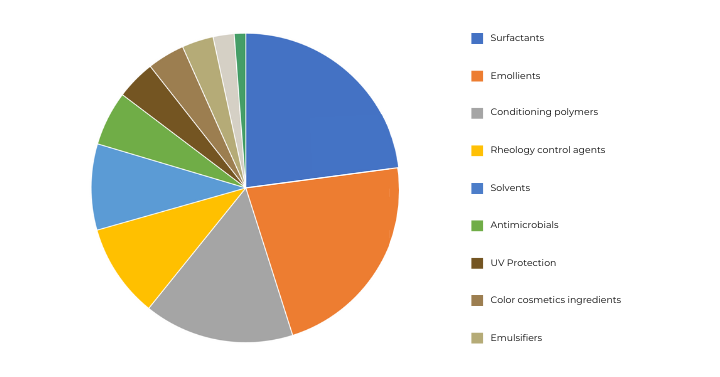In the expansive realm of beauty and personal care, the notion of sensoriality stands as a crucial element, transcending the conventional boundaries of utility. Sensoriality, in this context, denotes the creation of products that transcend mere functionality to offer an immersive experience, captivating not just the skin but also the emotions. This article delves into the essence of sensoriality and sheds light on key personal care ingredients contributing to this multisensory journey.
Kline defines sensoriality as an artistic endeavor aimed at crafting products that surpass their practical applications. It is about transforming routine tasks into indulgent rituals that engage the senses, providing a holistic and enjoyable encounter with each application.
Sensoriality plays a crucial and multifaceted role in the beauty industry. For many brands, it is of paramount importance for several reasons:
Enhanced Consumer Experience: Sensoriality transforms the application of beauty products into a sensory journey. The pleasant textures, fragrances, and overall experience contribute to a heightened sense of pleasure and indulgence, making the beauty routine more enjoyable.
Emotional Connection: Engaging multiple senses fosters an emotional connection between the consumer and the product. The way a product feels, smells, and looks can evoke positive emotions, creating a memorable and positive association with the brand.
Differentiation and Brand Identity: In a saturated market, sensorial experiences can set brands apart. Distinctive textures, innovative formulations, and appealing scents contribute to a unique brand identity that attracts and retains customers.
Holistic Well-being: Beauty routines are not just about physical appearance; they contribute to overall well-being. Sensoriality adds a dimension of self-care, allowing individuals to indulge in moments of relaxation and mindfulness during their beauty rituals.
Increased Product Loyalty: Consumers are more likely to remain loyal to products that provide a positive sensory experience. The pleasure derived from using a beauty product enhances customer satisfaction and fosters loyalty, leading to repeat purchases.
Positive Perception of Product Efficacy: A product that feels good and smells pleasant is often perceived as more effective. Even if the functional benefits remain constant, the sensory aspects contribute to the perception that the product is luxurious and high-quality.
Stress Reduction: Beauty routines, infused with sensorial elements, can serve as a form of stress relief. The calming scents and soothing textures create a moment of tranquility, contributing to overall mental well-being.
Innovation and Product Development: The pursuit of sensorial excellence drives innovation in product development. Beauty companies invest in research and development to create novel textures, fragrances, and application experiences, pushing the boundaries of what beauty products can offer.
Social Media Appeal: In the age of social media, products that provide a visually appealing and sensorially satisfying experience are more likely to be shared and endorsed by influencers and consumers. This can significantly impact brand visibility and desirability.
Adaptation to Consumer Trends: As consumer preferences evolve, there is a growing demand for products that offer a holistic experience. Brands that adapt to these trends by prioritizing sensoriality demonstrate responsiveness to consumer needs.
What are the Main Ingredients Behind Sensoriality?
To reach these sensorial features, personal care ingredients play a crucial role. Kline tracks specialty ingredients and assists its clients, such as Major Suppliers, distributors, contract manufacturers and leading cosmetic brands in understanding the evolution of consumer demand. Among the market of specialty ingredients that Kline estimates at about USD 19.2 billion globally in 2022, ingredients behind a formulation’s sensoriality are split between many ingredients categories.

Total: USD 19.2 Billion
Emollients and Moisturizers play a pivotal role, with shea butter, cocoa butter, and various plant-based oils offering a smooth, silky texture that makes products easy to apply. These ingredients also nourish and moisturize the skin, leaving it feeling soft and supple. We can mention natural extracts, such as aloe vera, chamomile, and green tea extract, that bring a touch of nature to personal care products, offering calming and soothing properties. They enhance the overall sensorial experience by promoting a connection to nature. Kline estimates that Natural oils represent about USD 1 billion globally, a significant part of the emollient group they belong to.
Fragrance and Essential Oils are powerful elements influencing the emotional response to a product. Lavender oil, rose extract, and citrus essential oils not only contribute pleasing scents but also offer additional skincare benefits.
Texture Modifiers, such as glycerin, hyaluronic acid, and silicones, enhance product texture and consistency, ensuring a pleasant feel on the skin. They contribute to the overall sensorial experience by providing a smooth and velvety sensation. Polymer Systems, encompassing ingredients like acrylates and crosslinked polymers, contribute to unique product textures, creating gel-like consistencies that feel both lightweight and luxurious. Those ingredients, mostly multifunctional in a formulation, are part of humectants, conditioning polymers, or rheology modifiers, all of which are key categories in a cosmetic formulation.
Exfoliants, such as alpha hydroxy acids (AHAs) and beta hydroxy acids (BHAs), renew and refresh the skin, adding a tactile element to the sensorial experience. They contribute to the overall smoothness and glow of the skin. Cooling and Warming Agents, featuring menthol, peppermint oil (cooling), and capsicum (warming), provide a sensory twist by creating cooling or warming sensations upon application. This enhances the overall experience and invigorates the skin.
To this list we can add the growing importance of Innovative Delivery Systems, utilizing microencapsulated actives and time-release technologies, contribute to the evolving field of sensoriality by ensuring a prolonged and gradual release of beneficial components. This enhances the overall longevity of the sensory experience.
In conclusion, sensoriality in beauty and personal care is a meticulous amalgamation of ingredients that engage the senses on multiple levels. From the silky touch of a moisturizer to the uplifting scent of a floral fragrance, each element contributes to a sensorial journey that transforms routine self-care into a moment of indulgence and joy. As consumers increasingly seek products offering more than functional benefits, the role of sensoriality becomes ever more vital in shaping the future of the beauty and personal care industry.
This article was first published in UL Prospector.
Explore Kline’s Ingredient Tracker and learn how our cutting-edge tool has been designed to revolutionize how you identify and size raw material opportunities in the personal care industry.
Don’t miss out, now available as an on-demand webinar – Next-Gen Raw Material Opportunities Identification: Kline’s Ingredient Tracker Unveiled


